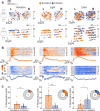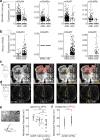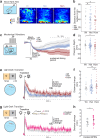Inhibition mediated by group III metabotropic glutamate receptors regulates habenula activity and defensive behaviors
- PMID: 40764295
- PMCID: PMC12325729
- DOI: 10.1038/s41467-025-62115-z
Inhibition mediated by group III metabotropic glutamate receptors regulates habenula activity and defensive behaviors
Abstract
Inhibition plays a key role in brain functions. While typically linked to GABA, inhibition can be induced by glutamate via metabotropic glutamate receptors (mGluRs). Here, we investigated the role of mGluR-mediated inhibition in the habenula, a conserved, glutamatergic brain hub involved in adaptive and defensive behaviors. We found that zebrafish and mice habenula express group III mGluRs. We showed that group III mGluRs regulate membrane potential and calcium activity of zebrafish habenula. Perturbing group III mGluRs increased sensory-evoked excitation and reduced selectivity. We identified inhibition as the primary communication mode among habenula neurons. Blocking group III mGluRs reduces this inhibition and increases neural synchrony. Consistently, we demonstrated that multisensory integration in the habenula relies on competitive suppression, that partly depends on group III mGluRs. Genetic and pharmacological perturbation of group III mGluRs amplified neural responses and defensive behaviors. Our findings highlight an essential role for mGluR-driven inhibition in encoding information and regulating defensive behaviors.
© 2025. The Author(s).
Conflict of interest statement
Competing interests: The authors declare no competing interests.
Figures







Similar articles
-
Activation of ionotropic and group I metabotropic glutamate receptors stimulates kisspeptin neuron activity in mice.J Neuroendocrinol. 2025 Jan;37(1):e13456. doi: 10.1111/jne.13456. Epub 2024 Oct 16. J Neuroendocrinol. 2025. PMID: 39414384 Free PMC article.
-
Depression of neuronal excitability and epileptic activities by group II metabotropic glutamate receptors in the medial entorhinal cortex.Hippocampus. 2015 Nov;25(11):1299-313. doi: 10.1002/hipo.22437. Epub 2015 Mar 26. Hippocampus. 2015. PMID: 25740117 Free PMC article.
-
Surrogate GPR139 Agonists Reverse Short-Term Startle Habituation Impairment in Larval Zebrafish.FASEB J. 2025 May 31;39(10):e70656. doi: 10.1096/fj.202500594R. FASEB J. 2025. PMID: 40402163 Free PMC article.
-
Molecular Basis for Modulation of Metabotropic Glutamate Receptors and Their Drug Actions by Extracellular Ca2.Int J Mol Sci. 2017 Mar 21;18(3):672. doi: 10.3390/ijms18030672. Int J Mol Sci. 2017. PMID: 28335551 Free PMC article. Review.
-
Role of mGluR7 in Alzheimer's disease: pathophysiological insights and therapeutic approaches.Inflammopharmacology. 2025 Jun;33(6):2977-2995. doi: 10.1007/s10787-025-01765-3. Epub 2025 May 3. Inflammopharmacology. 2025. PMID: 40316832 Review.
References
-
- Cossart, R. et al. Dendritic but not somatic GABAergic inhibition is decreased in experimental epilepsy. Nat. Neurosci.4, 52–62 (2001). - PubMed
-
- Semyanov, A., Walker, M. C. & Kullmann, D. M. GABA uptake regulates cortical excitability via cell type–specific tonic inhibition. Nat. Neurosci.6, 484–490 (2003). - PubMed
MeSH terms
Substances
Grants and funding
LinkOut - more resources
Full Text Sources

